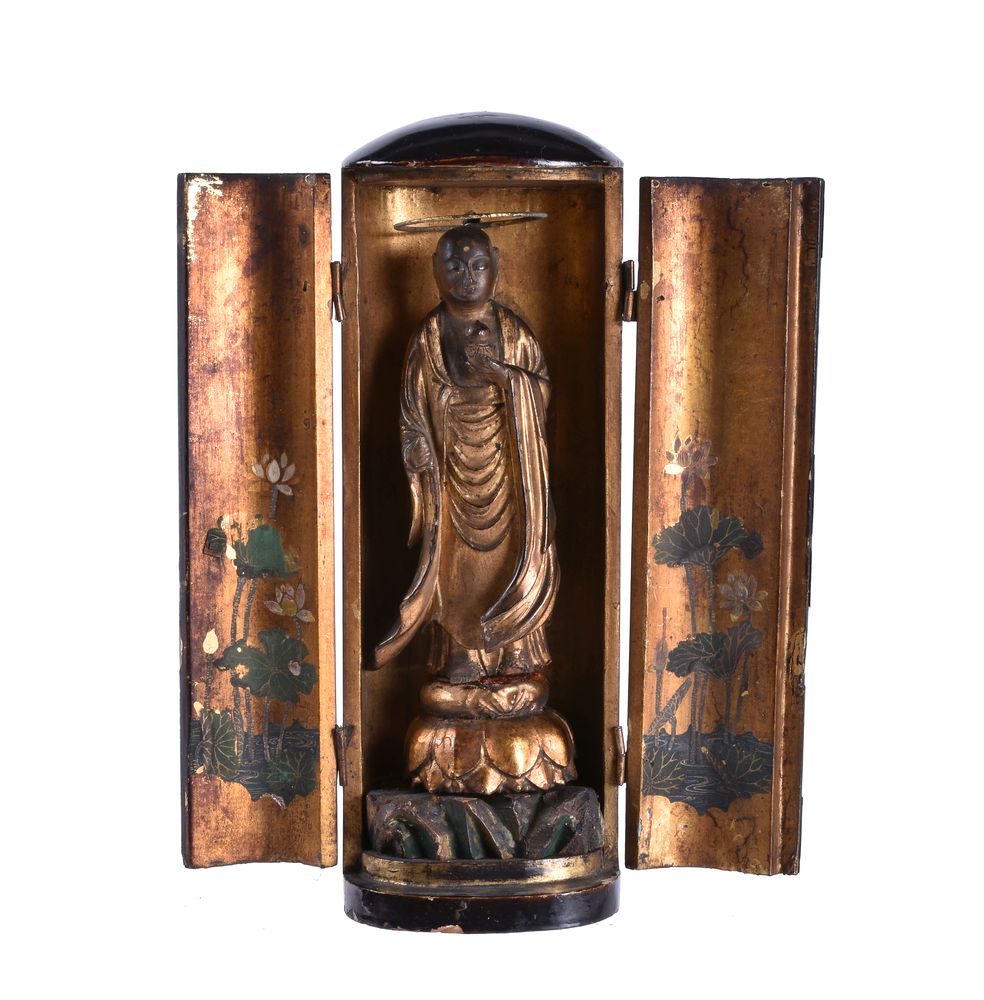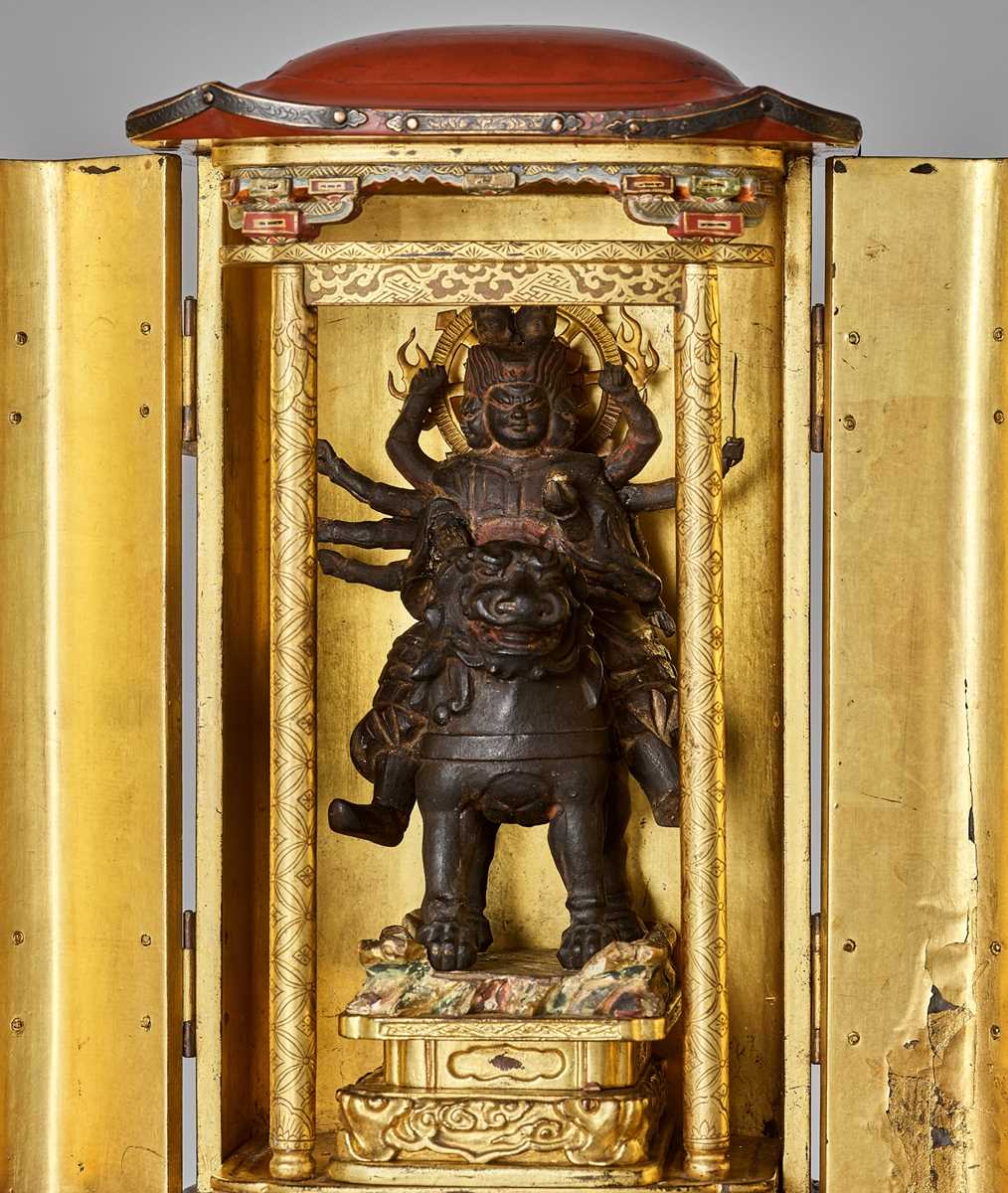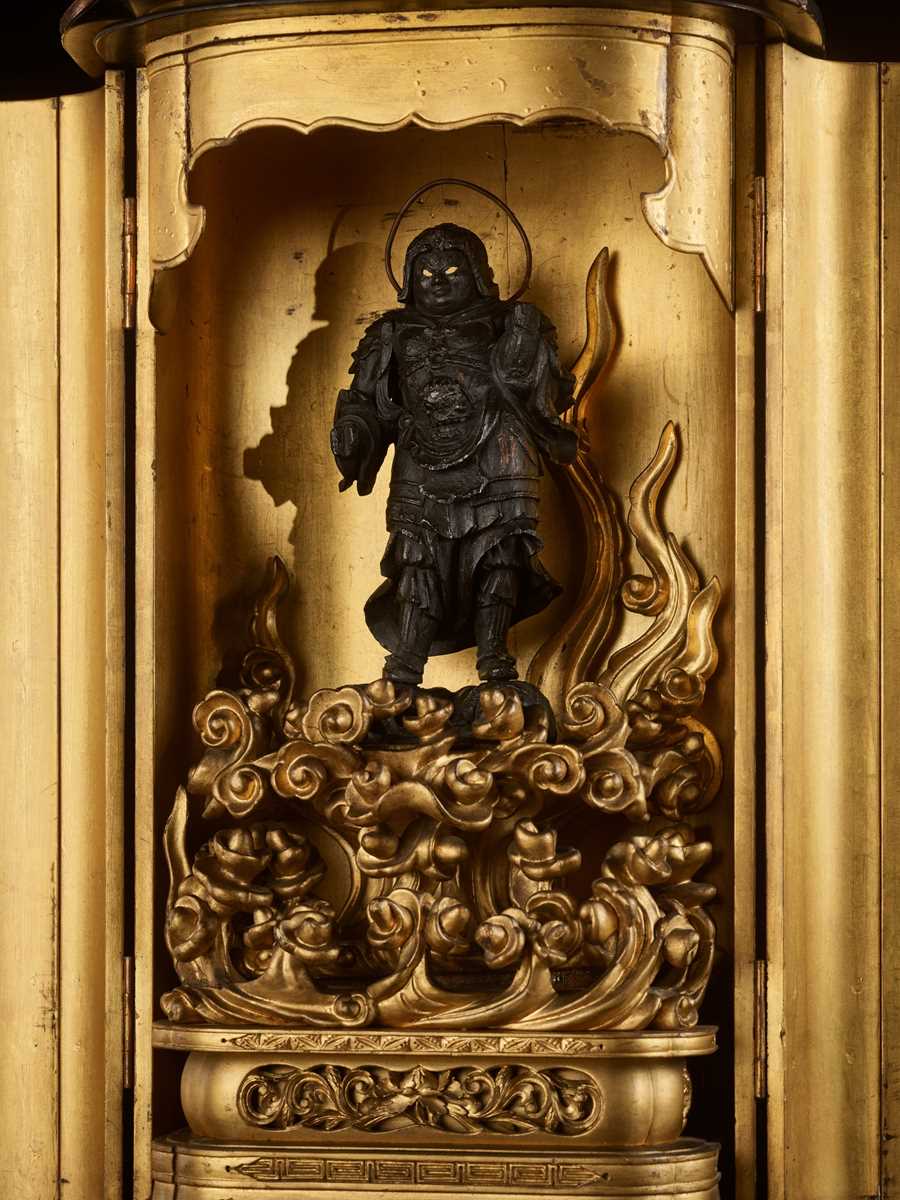Lot details Japan, Chiryuzan temple, Tosa province, Shikoku Island, Edo period (1615-1868) Kukai is seated in dhyanasana on a raised pedestal carved partly in openwork with railings fitted with chased metal finials. The figure wears black and orange monastic robes, pooling elegantly around him, and holds a vajra in his right hand and mala beads made of rock crystal in his left. The face of the monk bears a contemplative expression, his lips painted a fleshy pink, his eyes inlaid and behind transparent glass or rock crystal. Two gilt slippers are placed within the interior of the pedestal. The interior of the doors is covered in gold lacquer, while the rest of the interior and exterior are covered in matte and occasionally glossy black lacquer. HEIGHT 39.4 cm Condition: Good condition with minor wear, small age cracks, light chips, minuscule dents, and minor touchups. Provenance: From a private collection in Germany. With an old paper script from the late 19th to early 20th century sealed with the Dainichi Nyorai seed syllable, ‘āṃḥ, which is part of the Mahāvairocana within the Vajradhatu mandala. Beneath the seal is a drawing of the priest Kukai seated as he is in the sculpture and below is written, Tosa no kuni, Chiryuzan 土佐国、踟躘山 [‘The Chiryuzan temple, Tosa province’]. Kukai (774-835), posthumously called Kobo Daishi [‘The Grand Master who Propagated the Dharma’], was a Japanese Buddhist monk, calligrapher, and poet who founded the esoteric Shingon school of Buddhism. He travelled to China, where he studied Tangmi (Chinese Vajrayana Buddhism) under the monk Huiguo. Upon returning to Japan he founded Shingon, the Japanese branch of Vajrayana Buddhism. With the blessing of several Emperors Kukai was able to preach Shingon teachings and found Shingon temples. Like other influential priests, Kukai oversaw public works and constructions. He chose Mount Koya as a holy site, spending his final years there until his death in 835 AD. According to the note accompanying this lot, the Chiryuzan temple is located on the Shikoku island. This temple was likely a part of the 88 temple complexes which exist on the island. However, this temple name has not been preserved. The first two characters, 踟躘, are antique kanji characters which do not correspond with any existing temple name. It is possible the temple either no longer exists under this name or has been lost to time. However, it is clear this traveling shrine was intended for this temple, a temple founded by or dedicated to Kukai.
Lot details Japan, Chiryuzan temple, Tosa province, Shikoku Island, Edo period (1615-1868) Kukai is seated in dhyanasana on a raised pedestal carved partly in openwork with railings fitted with chased metal finials. The figure wears black and orange monastic robes, pooling elegantly around him, and holds a vajra in his right hand and mala beads made of rock crystal in his left. The face of the monk bears a contemplative expression, his lips painted a fleshy pink, his eyes inlaid and behind transparent glass or rock crystal. Two gilt slippers are placed within the interior of the pedestal. The interior of the doors is covered in gold lacquer, while the rest of the interior and exterior are covered in matte and occasionally glossy black lacquer. HEIGHT 39.4 cm Condition: Good condition with minor wear, small age cracks, light chips, minuscule dents, and minor touchups. Provenance: From a private collection in Germany. With an old paper script from the late 19th to early 20th century sealed with the Dainichi Nyorai seed syllable, ‘āṃḥ, which is part of the Mahāvairocana within the Vajradhatu mandala. Beneath the seal is a drawing of the priest Kukai seated as he is in the sculpture and below is written, Tosa no kuni, Chiryuzan 土佐国、踟躘山 [‘The Chiryuzan temple, Tosa province’]. Kukai (774-835), posthumously called Kobo Daishi [‘The Grand Master who Propagated the Dharma’], was a Japanese Buddhist monk, calligrapher, and poet who founded the esoteric Shingon school of Buddhism. He travelled to China, where he studied Tangmi (Chinese Vajrayana Buddhism) under the monk Huiguo. Upon returning to Japan he founded Shingon, the Japanese branch of Vajrayana Buddhism. With the blessing of several Emperors Kukai was able to preach Shingon teachings and found Shingon temples. Like other influential priests, Kukai oversaw public works and constructions. He chose Mount Koya as a holy site, spending his final years there until his death in 835 AD. According to the note accompanying this lot, the Chiryuzan temple is located on the Shikoku island. This temple was likely a part of the 88 temple complexes which exist on the island. However, this temple name has not been preserved. The first two characters, 踟躘, are antique kanji characters which do not correspond with any existing temple name. It is possible the temple either no longer exists under this name or has been lost to time. However, it is clear this traveling shrine was intended for this temple, a temple founded by or dedicated to Kukai.















Testen Sie LotSearch und seine Premium-Features 7 Tage - ohne Kosten!
Lassen Sie sich automatisch über neue Objekte in kommenden Auktionen benachrichtigen.
Suchauftrag anlegen